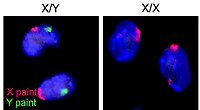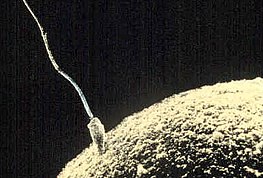| Part of a series on |
| Sex |
|---|
 |
| Biological terms |
| Sexual reproduction |
| Sexuality |
| Sexual system |
A gamete (/ˈɡæmiːt/; from Ancient Greek γαμετή (gametḗ) 'wife', ultimately from Ancient Greek γάμος (gámos) 'marriage') is a haploid cell that fuses with another haploid cell during fertilization in organisms that reproduce sexually. Gametes are an organism's reproductive cells, also referred to as sex cells. The name gamete was introduced by the German cytologist Eduard Strasburger in 1878.
Gametes of both mating individuals can be the same size and shape, a condition known as isogamy. By contrast, in the majority of species, the gametes are of different sizes, a condition known as anisogamy or heterogamy that applies to humans and other mammals. The human ovum has approximately 100,000 times the volume of a single human sperm cell. The type of gamete an organism produces determines its sex and sets the basis for the sexual roles and sexual selection. In humans and other species that produce two morphologically distinct types of gametes, and in which each individual produces only one type, a female is any individual that produces the larger type of gamete called an ovum, and a male produces the smaller type, called a sperm cell or spermatozoon. Sperm cells are small and motile due to the presence of a tail-shaped structure, the flagellum, that provides propulsion. In contrast, each egg cell or ovum is relatively large and non-motile.
Oogenesis, the process of female gamete formation in animals, involves meiosis (including meiotic recombination) of a diploid primary oocyte to produce a haploid ovum. Spermatogenesis, the process of male gamete formation in animals, involves meiosis in a diploid primary spermatocyte to produce haploid spermatozoa. In animals, ova are produced in the ovaries of females and sperm develop in the testes of males. During fertilization, a spermatozoon and an ovum, each carrying half of the genetic information of an individual, unite to form a zygote that develops into a new diploid organism.
Evolution
Main article: Evolution of sexual reproductionIt is generally accepted that isogamy is the ancestral state from which anisogamy and oogamy evolved, although its evolution has left no fossil records. There are almost invariably only two gamete types, all analyses showing that intermediate gamete sizes are eliminated due to selection. Since intermediate sized gametes do not have the same advantages as small or large ones, they do worse than small ones in mobility and numbers, and worse than large ones in supply.
Differences between gametes and somatic cells
In contrast to a gamete, which has only one set of chromosomes, a diploid somatic cell has two sets of homologous chromosomes, one of which is a copy of the chromosome set from the sperm and one a copy of the chromosome set from the egg cell. Recombination of the genes during meiosis ensures that the chromosomes of gametes are not exact duplicates of either of the sets of chromosomes carried in the parental diploid chromosomes but a mixture of the two.

Artificial gametes
Artificial gametes, also known as in vitro derived gametes (IVD), stem cell-derived gametes (SCDGs), and in vitro generated gametes (IVG), are gametes derived from stem cells. The use of such artificial gametes would "necessarily require IVF techniques". Research shows that artificial gametes may be a reproductive technique for same-sex male couples, although a surrogate mother would still be required for the gestation period. Women who have passed menopause may be able to produce eggs and bear genetically related children with artificial gametes. Robert Sparrow wrote, in the Journal of Medical Ethics, that embryos derived from artificial gametes could be used to derive new gametes and this process could be repeated to create multiple human generations in the laboratory. This technique could be used to create cell lines for medical applications and for studying the heredity of genetic disorders. Additionally, this technique could be used for human enhancement by selectively breeding for a desired genome or by using recombinant DNA technology to create enhancements that have not arisen in nature.
Plants
Plants that reproduce sexually also produce gametes. However, since plants have a life cycle involving alternation of diploid and haploid generations some differences from animal life cycles exist. Plants use meiosis to produce spores that develop into multicellular haploid gametophytes which produce gametes by mitosis. In animals there is no corresponding multicellular haploid phase. The sperm of plants that reproduce using spores are formed by mitosis in an organ of the gametophyte known as the antheridium and the egg cells by mitosis in a flask-shaped organ called the archegonium. Plant sperm cells are their only motile cells, often described as flagellate, but more correctly as ciliate. Bryophytes have 2 flagella, horsetails have up to 200 and the mature spermatozoa of the cycad Zamia pumila has up to 50,000 flagella. Cycads and Ginkgo biloba are the only gymnosperms with motile sperm. In the flowering plants, the female gametophyte is produced inside the ovule within the ovary of the flower. When mature, the haploid gametophyte produces female gametes which are ready for fertilization. The male gametophyte is produced inside a pollen grain within the anther and is non-motile, but can be distributed by wind, water or animal vectors. When a pollen grain lands on a mature stigma of a flower it germinates to form a pollen tube that grows down the style into the ovary of the flower and then into the ovule. The pollen then produces non-motile sperm nuclei by mitosis that are transported down the pollen tube to the ovule where they are released for fertilization of the egg cell.
See also
Notes and references
- "gamete | Definition, Formation, Examples, & Facts". Encyclopedia Britannica. Retrieved 20 October 2020.
- ^ "gamete / gametes | Learn Science at Scitable". www.nature.com. Retrieved 20 October 2020.
- "gamete | Etymology of gamete by etymonline". www.etymonline.com. Retrieved 6 June 2024.
- Cotner S, Wassenberg D, "8.4 Sex: It's About the Gametes", The Evolution and Biology of Sex, retrieved 20 October 2020
- Fusco G, Minelli A (10 October 2019). The Biology of Reproduction. Cambridge University Press. pp. 111–112. ISBN 978-1-108-49985-9.
- Pitnick SS, Hosken DJ, Birkhead TR (2008). Sperm Biology: An Evolutionary Perspective. Academic Press. pp. 43–44. ISBN 978-0-08-091987-4.
- Awasthi AK. Textbook of Algae. Vikas Publishing House. p. 363. ISBN 978-93-259-9022-7.
- Dusenbery DB (2009). Living at Micro Scale: The Unexpected Physics of Being Small. Harvard University Press. p. 309. ISBN 978-0-674-03116-6.
- Stearns SC (21 November 2013). The Evolution of Sex and its Consequences. Birkhäuser. pp. 21, 81–82. ISBN 978-3-0348-6273-8.
- Lehtonen J, Parker GA (December 2014). "Gamete competition, gamete limitation, and the evolution of the two sexes". Molecular Human Reproduction. 20 (12): 1161–1168. doi:10.1093/molehr/gau068. PMID 25323972.
- Campbell A (16 May 2013). A Mind Of Her Own: The evolutionary psychology of women. OUP Oxford. p. 45. ISBN 978-0-19-164701-7.
- Bachtrog D, Mank JE, Peichel CL, Kirkpatrick M, Otto SP, Ashman TL, et al. (July 2014). "Sex determination: why so many ways of doing it?". PLOS Biology. 12 (7): e1001899. doi:10.1371/journal.pbio.1001899. PMC 4077654. PMID 24983465. S2CID 3741933.
- "Mitosis, Meiosis, and Inheritance | Learn Science at Scitable". www.nature.com. Retrieved 1 March 2021. Consequently, the cells of the offspring have genes potentially capable of expressing some of the characteristics of both the father and the mother, subject to whether they are dominant or recessive.
- ^ Newson AJ, Smajdor AC (March 2005). "Artificial gametes: new paths to parenthood?". Journal of Medical Ethics. 31 (3): 184–186. doi:10.1136/jme.2003.004986. PMC 1734101. PMID 15738444.
Pregnancies brought about by means of artificial gametes would necessarily require IVF techniques
- ^ Sparrow R (November 2014). "In vitro eugenics". Journal of Medical Ethics. 40 (11): 725–731. doi:10.1136/medethics-2012-101200. PMID 23557913. S2CID 959092.
- Sporne KR (2022). The morphology of Pteridophytes; the structure of ferns and allied plants. Legare Street Press. ISBN 978-1015505667.
- ^ Wolniak SM, Klink VP, Hart PE, Tsai CW (June 2000). "Control of development and motility in the spermatozoids of lower plants". Gravitational and Space Biology Bulletin. 13 (2): 85–93. PMID 11543285.
- Norstog KJ (1986). "The blepharoplast of Zamia pumila L.". Botanical Gazette. 147 (1): 40–46. doi:10.1086/337566. S2CID 85257438.